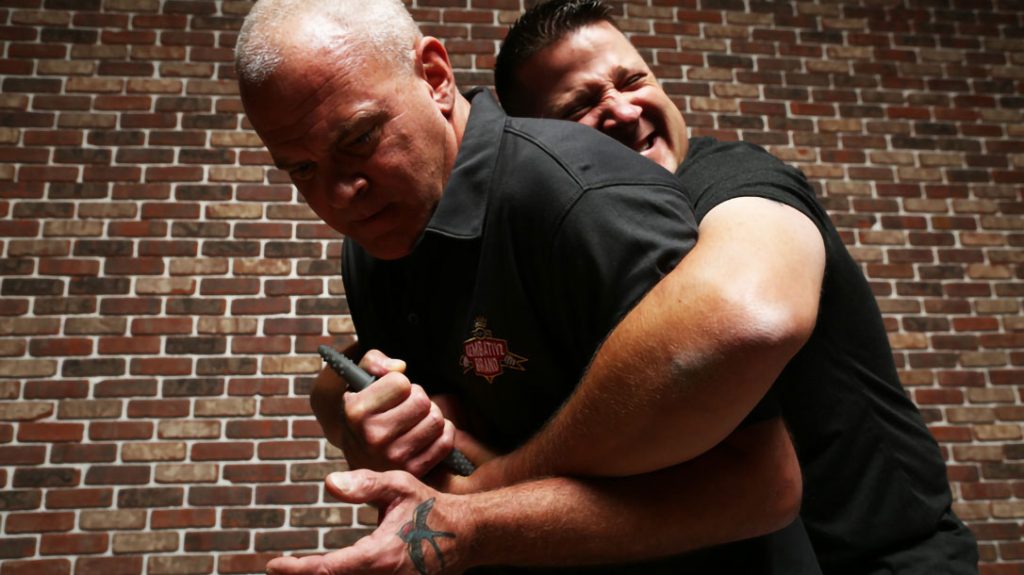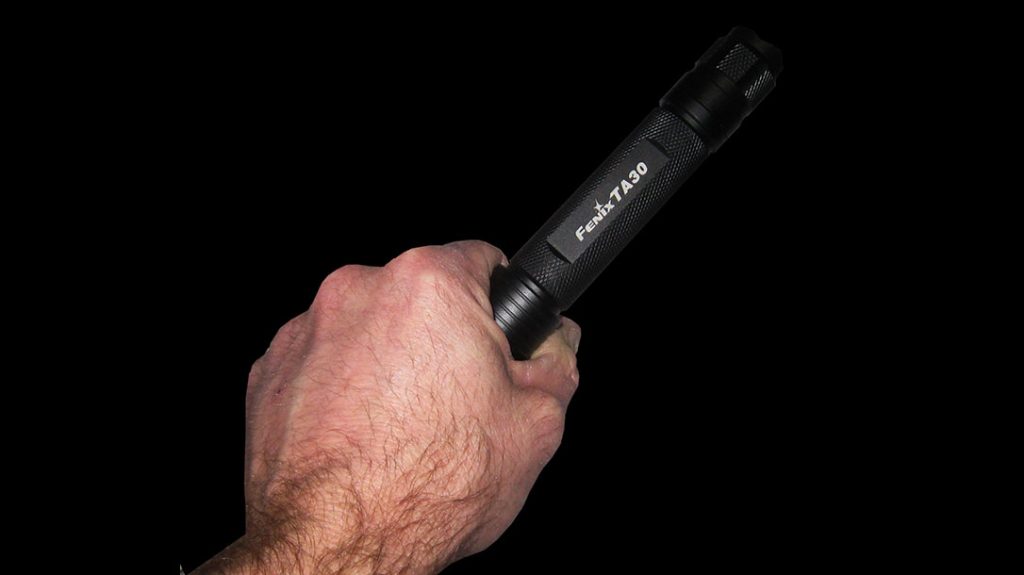In the realm of professional-level violence, there are few people more knowledgeable than Kelly McCann. A former tier-one unit member, McCann was one of the United States military’s prime subject matter experts for unarmed combat. If anything, he’s even more highly regarded with a firearm, considered among the world’s leading authorities on combat handgunning. Today we take a look at his thoughts on non-lethal self-defense options.
Thank you for reading this post, don't forget to follow and signup for notifications!
Non-Lethal Self-Defense in an Increasingly Violent World
McCann still indulges both passions. His Renegade Combat Sports Club produces successful pro mixed martial arts fighters. And he continues to travel the world training civilian, law enforcement, and military clients in shooting.
But there is a third area lying between empty hands and firearms, which McCann is equally skillful with. It’s what he likes to call “bridge weapons,” those alternatives which fall between being unarmed and employing lethal weaponry.
The Less-than-Lethal Option
Bridge weapons can serve to hurt or distract an attacker but with far less likelihood of a lethal outcome. Using a knife or gun might possibly be justified in something like a home invasion, even if the perpetrator’s unarmed. But in public, if you use a deadly weapon against an unarmed attacker, you may be inviting major legal trouble.
“A lot of guys arm themselves with knives and guns, and those are very effective weapons. But what you’ve just done is armed yourself for about 2% of the violent situations you might be in,” said McCann.
He continued, “Without a bridge weapon, you’re going to have to go from empty hands to lethal force. While they might be less effective than lethal weapons, bridge weapons are way more effective than just empty hands. They also can be more legally defensible than a deadly weapon.”

There are a number of non-lethal self-defense products that can be carried for personal safety. When possible, McCann prefers ones that create distance over those you have to get very close to use. That’s partly because the closer you get, the more skill is usually required to use a bridge weapon effectively. But longer-range weapons may not always be an option.
“Yes, if I can conceal carry it, I’d rather have a 21-inch ASP baton than a pocket stick. But an ASP isn’t legal in all jurisdictions,” said McCann.
So, let’s look at some pros and cons for the major types of less-than-lethal self-defense weapons:
Pain Compliance Tools
While short sticks, like a Kubotan, can only be used up close and require some skill, they’re highly concealable. They also have the benefit of being legally defensible. Attach your keys to one, and you essentially have a long key chain. That’s going to draw much less of a reaction from police than something like a knife, says McCann.
Though they will require some technique and practice to use, they can be effective, especially in a grappling situation. Digging the end of a hard stick into vulnerable points on an opponent’s body can make even expert grapplers uncomfortable.

But the idea isn’t to use them to submit an attacker. Rather, the goal is to break their hold so you can escape. Against a lapel grab, you can simply jam the end of the tool into the attacker’s forearm and pull back. For most people, that will be enough to make them release their grip.
McCann has found real-life use for these seemingly innocuous sticks on several occasions.
McCann said, “One time, I was working in a foreign country when I was jumped returning to my hotel. I wasn’t time or place predictable, so I don’t know if it was a random criminal attack or something else.”
“But I had the pain compliance tool with me and planted the end of it in his clavicle notch. The guy stopped fighting me and was suddenly fighting to get away from me. That’s all you need to break contact. He turned and ran, and so did I,” he concluded.
Electric Devices
“Besides Tasers, which are in another class, things like stun guns are pretty much useless other than the show of them,” said McCann.
The fierce crackle and burning ozone smell that accompanies setting off a stun gun can make some people back down. But McCann said anyone with a truly combative mentality will probably just get irritated if you zap them with one.
“We used to take one of the 5-million-volt ones and go out to the pub. Guys would get hammered and just start shocking themselves for fun,” recalled McCann.
Impact Tools
McCann is a big believer in the value of impact tools like collapsible batons. Though these weapons still require some level of skill, they require less than a short stick. You can largely just stand back from an opponent and swing away.
Though the spring mechanisms of inexpensive collapsible batons may sometimes break, good ones can usually stand up to impacts. McCann recommends the Bonowi baton as about the best on the market now. But one caveat is to avoid targeting the head unless you find yourself in a truly life-threatening situation. Head shots can cause fatal damage.

But even without targeting the head, batons can prove extremely useful. McCann found that out once in a foreign country while working a protection detail.
He remembered, “We came across another official with his own detail of local soldiers. There was a dispute, and one of the soldiers started to draw his gun. I had an ASP in my hand, brought it down hard, and think I pretty much shattered his forearm. He didn’t draw the gun…”
Noise Generators
While these can serve to call attention to yourself and a potential attacker, they won’t do anything to physically deter someone. McCann said that although companies have tried to create noise generators powerful enough to debilitate an attacker, they just don’t.
Flashlights
A flashlight is, perhaps, the easiest of these tools to use. Just point it toward an assailant and shine it in his face to momentarily blind him. The brighter the light is, the better, and McCann particularly likes ones capable of stroboscopic effects.
He recommends tactical flashlights that are at least 8 inches long. That’s big enough to protrude from your pocket, making them easier to draw. It can also be used as an impact tool. But he cautions against getting the kind with sharp, cutting edges. He said all they do is cause small cuts and punctures and might prove legally problematic.

In uncertain situations, flashlights can also be effectively paired with a firearm.
“You can hit them with the light, then draw your gun, and they may not even know you’ve drawn. It allows you to verbally warn them off while holding your weapon on them. Then you can put the gun away. That’s the way it’s played out for me many times, and people were never even aware I had my weapon out,” he said.
Aerosol Chemical Irritants
If there’s one less-than-lethal tool that McCann recommends, it’s this one. They’re usually concealable, and they don’t require as much skill to use as a pocket stick. While he’s not a fan of tear gas sprays, pepper sprays can be highly effective, he said. Though 6% of people aren’t affected by them, when used properly, the other 94% will have an adverse reaction.
But according to McCann, you need to use a pepper mixture of at least 2 million Scovilles. He also prefers ones that spray in a fogger rather than a stream. They’re best viewed as an area denial tool. Spray the fog in a figure 8 pattern in front of you to create a barrier. And make sure to back away rather than step forward and catch a face full of it yourself.
“We’ve used these on deployment when we thought we were being followed by someone. We’d just spray a wall of it behind us, and you can hear them going, ‘Screw this!’” said McCann.
But as with most of these tools, pepper spray should be supported by some unarmed combat skill. A person affected by it might still be able to stagger forward and grab you. So at least knowing some basic footwork will enable you to sidestep.
McCann is quick to point out that few of these non-lethal self-defense tools are fight-enders. Instead, he calls them “fight benders,” defense devices that can create situations that are more advantageous for you.
Final Points
Less-than-lethal weapons can be effective for non-lethal self-defense and might bring you some additional peace of mind. But their main strength, said McCann, isn’t necessarily what they can do in a fight. It’s that they should serve as a reminder you’re in a potentially dangerous situation.
“Whenever you think about any weapon or touch it, that’s a trigger telling you to leave the situation you’re in. If you put a pocket stick in your hand and continue to stay where you are, you’re wrong. The minute you reach for it, you should be walking for the door.”
To learn more about Kelly McCann, please visit Kembativz.com.

The post Non-Lethal Self-Defense: Less Than Lethal (But Still Pretty Darn Effective) appeared first on Personal Defense World.



